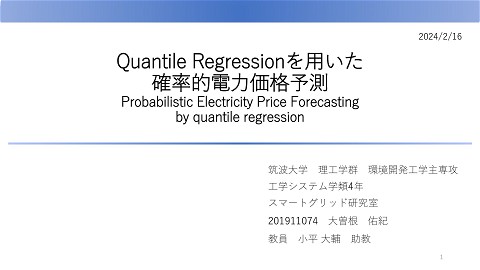2021_Improving Forecast Reliability for Geographically Distributed PV
259 Views
March 31, 22
スライド概要
Kodaira, D.; Tsukazaki, K.; Kure, T.; Kondoh, J. Improving Forecast Reliability for Geographically Distributed Photovoltaic Generations. Energies 2021, 14, 7340. https://doi.org/10.3390/en14217340
小平大輔 - 筑波大学エネルギー・環境系助教。現在の研究テーマは、電気自動車の充電スケジューリング、エネルギー取引のためのブロックチェーン、太陽光発電とエネルギー需要の予測など。スライドの内容についてはお気軽にご相談ください:kodaira.daisuke.gf[at]u.tsukuba.ac.jp
関連スライド
各ページのテキスト
Improving Forecast Reliability for Geographically Distributed PV Daisuke Kodaira Assistant Professor Tokyo University of Science 1
Outline 01 02 Background 03 04 Data set 05 Conclusion Method Ensemble forecasting Prediction Interval Simulation Result 2
Outline 01 Background 3
Introduction – PV generation forecasting 1. Forecast PV generation for today ESS#2 to end of to ESS#1 to Ex)Substation Peak shaving in distribution network ESS#1: 5.8km PV Load 22.9kV line: 7.4km ESS#2: 9.5km ESS#1 PCS: 0.75MW ESS: 1.5MWh ESS#2 PCS: 1MW ESS: 2MWh 2. Calculate the optimal charge or discharge Reliable PV forecast improves the peak shaving performance Forecast MW Load on feeder [MW] Network operator controls ESSs by remote Case1 Case3 Case2 How do we perform reliable PV forecasting? Case1 hour 4
Objective of the research Existing works have drawbacks… ➢ Bad weather; The accuracy of the forecast based on machine learning decreases on days with bad weather ➢ Limited duration; Forecasting based on cloud movements keep the accuracy only within 30 min or few hours Good accuracy Bad accuracy Trace cloud movements (Optical flow) Objective ✓ Improves the reliability of the PV forecast based on neighboring PVs information 5
Deterministic forecasting PV generation kw The forecasting is not always reliable…. Observed PV generation 60 0 “Forecast tells us the peak is small today. we don’t need to absorb the PV generation” Forecasted PV generation 1 2 3 ・・・・ 23 hour Now Deterministic forecast cannot evaluate the risk of the error 6
Probabilistic forecasting The concept of probability is necessary to evaluate the risk Prediction Interval (PI) “Prediction tells us the EV demand falls into gray zone with 95% probability” Probabilistic forecast tells us how reliable the forecast is! 7
Outline 02 Method Ensemble forecasting Prediction Interval 8
Overview of the Single/Multiple PV forecast model Past Generation of Weather Data of the area Data base Past Generation of Weather Data of the area Past Generation of Weather Data of the area Single PV Forecast model for Single PV Forecast model for Forecasted Generation for Forecasted Generation for ⋮ Single PV Forecast model for Forecasted Generation for Forecasted Generation for Multiple PV Forecast model 𝑃𝑉2 𝑃𝑉1 Past Generation of Weather Data of the area 𝑃𝑉3 𝑃𝑉4 9
Ensemble method for forecasting ➢ Each machine learning (ML) method has its own characteristics ➢ No model is always better than another. -> Combine models that have good accuracy with high weighting on the most recent data •(Good) Low computational complexity •(Good) Handle discrete time series •(Bad) Relationship in time instances is ignored ML models Neural network Optimize the weight for each model based on the past accuracy Weight optimizer •(Good) Low computational complexity •(Bad) Every predictor must be independent of each other K-means + Naive Bayes Classifier •(Good) Consider relationship in time instances •(Bad) High computational complexity Long shortterm memory The ultimate forecasting model Ensemble Forecasting model 10
Weight optimization by Particle Swarm Optimization Forecasted PV generation Load on feeder [MW] Observed PV generation 𝑦ෝ𝑡 : Forecasting at time instace 𝑡 𝑦ෝ𝑡 = 𝑐1 𝐹𝑘−𝑚𝑒𝑛𝑎𝑠 + 𝑐2𝐹𝑁𝑁 + 𝑐3𝐹𝐿𝑆𝑇𝑀 𝑒𝑟𝑟𝑜𝑟 = 𝑦𝑡 − 𝑦ෝ𝑡 1 2 3 Time instances t in a day 48 𝑖 Target: 𝕐 ≔ 𝑦1 , 𝑦2 , … 𝑦𝑡 … 𝑦48 Forecasting: 𝕐 ≔ 𝑦ො𝟏 , 𝑦ො2, … 𝑦ොt … 𝑦ො48 Optimize the weight with the objective function 𝒂𝒓𝒈 𝐦𝐢𝐧 𝕐 − 𝕐 𝑐 2 11
12 Compose Prediction Interval (PI) Deterministic prediction Deterministic prediction Deterministic prediction ・・・・・ Day 2 Probability Day 1 Day 3 Error distribution for 0am~1am Error rate[%] Create PI by Sample-based method The error is assumed to follow the normal distribution, calculate 95% confidence interval 𝑢𝑝𝑝𝑒𝑟 𝑏𝑜𝑢𝑛𝑑𝑎𝑟𝑦 = 𝜇 + 2𝜎 𝑙𝑜𝑤𝑒𝑟 𝑏𝑜𝑢𝑛𝑑𝑎𝑟𝑦 = 𝜇 − 2𝜎 12
Evaluation criteria for Probabilistic forecasting ・Deterministic perspective Root-mean-square-Error (RMSE)[kW]; 𝑅𝑀𝑆𝐸 = 1 𝑛 σ 𝑛 𝑖=1 𝑦𝑖 − 𝑦ෝ𝑖 2 (4) 𝑛:Time instances in a day (48) 𝑦:Observed PV generation 𝑦:Forecasted ො PV generation Upper boundary Generation [kw] ・Probabilistic perspective Cover rate[%]; How much of the measured power output falls within the prediction interval 1 𝑐𝑜𝑣𝑒𝑟 𝑟𝑎𝑡𝑒 = 100 × σ𝑛𝑖=1 𝑐𝑜𝑢𝑛𝑡𝑖 (5) Observed Lower boundary 𝑛 𝑐𝑜𝑢𝑛𝑡𝑖 :The number of records in the boundaries Prediction Interval [kW]; How much of the width of the boundaries Time 𝐶𝑜𝑣𝑒𝑟 rate = 100 × 4 = 80[%] 5 13
Outline 03 Data set for simulation 14
Simulation data set Predictors Year Month Day Time Temperature Precipitation Example Description 2013 08 15 6.5 26.9 6 August 15th 6:30AM ℃ mm Target PV generation Example 6.0 Description kW 15
Forecasting framework • One day-ahead forecasting • 48 time slots in a day (on 30 minutes basis) • Forecasting errors in validation data are accumulated for PI composition • Duration Training and Validation: 1 year (2013/8/15 – 2014/7/1) Forecast: 30 days (2014/7/2 - 2014/7/31) 16
Simulation data set PV (ii) PV (v) PV (iii) PV (i) PV (iv) Figure. Location of the PV systems to be forecasted in Japan. 17
Outline 04 Simulation Result 18
Simulation data set PV (ii) PV (v) PV (iii) PV (i) PV (iv) Figure. Location of the PV systems to be forecasted in Japan. 19
Simulation Result for one day (PI cover rate) PV (iii) on 11 July 2014 The worst PI cover rate day among 30 days Single PV forecast model for PV (iii) (Cover rate = 72%). Multiple PV forecast model for PV (iii) (Cover rate = 100%) 20
Simulation data set Forecast each PV based on others PV (ii) PV (v) PV (iii) PV (i) PV (iv) 21
Simulation Result for one month PV (i) PV (i) PV (ii) PV (iii) PV (iv) PV (v) Fig. Prediction interval coverage rate during the forecasting period (Higher is the better ) PV(i) and PV(v) in edge don’t improve PV (ii) PV (iii) PV (iv) PV (v) Fig. 9. Root-mean-square error during the forecasted 30 days (Smaller is the better) All PV improves in terms of RMSE 22
Simulation Result for one month PV (i) PV (ii) PV (iii) PV (iv) PV (v) Fig. Prediction interval width (Smaller is the better) All PV improve in terms of PI width 23
Conclusion Summary • This study proposed a multiple PV forecast model based on ensemble forecasting for distributed PV in a specific area. • The proposed multiple PV forecast model utilizes the neighboring PV forecast result based on the proposed ensemble forecast method. Conclusion • In the simulation result, the proposed multiple PV forecast model provides more reliable PIs for probabilistic forecasting and fewer RMSE for deterministic forecasting. Thank you for your kind attention! 24
Appendix 25
K-means, Neural Network k-means clustering Simple Neural network 10 5 0 -10 -5 0 5 10 -5 Year Month Day Hour Quarter DayOfWeek Holiday Charging demand -10 ① k個のクラスターの初期値をランダムに決定する ② 距離に基づいてデータのすべてのサンプルをク ラスターに割り当てる ③ 各クラスターのデータサンプルの重心を使用し てクラスターの中心を決定する ④ 適切にクラスターが収束されるまで繰り返す パラメータ 26
Long short-term memory (LSTM) x:入力 c:過去のデータ h:出力 f:忘却ゲート g:セル候補 i:入力ゲート o:出力ゲート LSTMは学習情報を長期間保持でき、時系列データを扱う学習に有効 27
Various Prediction Intervals (PI) Past Load and PIs Chebyshev Confidence Interval Sample base Each PI has another boundaries. Sample-based method shows the most optimistic one and Chebyshev shows the most pessimistic one 28
Construction of PIs • Window Pick the 5% and 95% data in ascending data as the boundaries. 1 2 3 4 5 6 7 8 9 10 𝑙𝑜𝑤𝑒𝑟 𝑏𝑜𝑢𝑛𝑑𝑎𝑟𝑦 = 10 ∗ 0.05 → 1 𝑢𝑝𝑝𝑒𝑟 𝑏𝑜𝑢𝑛𝑑𝑎𝑟𝑦 = 10 ∗ 0.95 → 10 • Confidence Interval The data is assumed to follow the normal distribution, calculate 95% CI 𝑙𝑜𝑤𝑒𝑟 𝑏𝑜𝑢𝑛𝑑𝑎𝑟𝑦 = 𝜇 − 2𝜎 𝑢𝑝𝑝𝑒𝑟 𝑏𝑜𝑢𝑛𝑑𝑎𝑟𝑦 = 𝜇 + 2𝜎 • Chebyshev Chebyshev’s inequality ensure the certain percentage of data lays in certain range 1 𝑃 𝑥 − 𝜇 ≥ 𝑘𝜎 ≤ 2 𝑘 29
Single forecast model - flow Training: train ensemble forecast model Training Process with past data Validation: Deterministic forecasting Eistribution for PI Forecast: get Error distribution for PI Forecast process with test data 30
Compose Prediction Interval (PI) Forecasted PV generation Load on feeder [MW] Observed PV generation 𝑦ෝ𝑡 : Forecasting at time instace 𝑡 𝑦ෝ𝑡 = 𝑐1 𝐹𝑘−𝑚𝑒𝑛𝑎𝑠 + 𝑐2𝐹𝑁𝑁 + 𝑐3𝐹𝐿𝑆𝑇𝑀 𝑖 Target: 𝕐 ≔ 𝑦1 , 𝑦2 , … 𝑦𝑡 … 𝑦48 Forecasting: 𝕐 ≔ 𝑦ො𝟏 , 𝑦ො2, … 𝑦ොt … 𝑦ො48 1 2 3 𝑒𝑟𝑟𝑜𝑟 = 𝑦𝑡 − 𝑦ෝ𝑡 48 Time instances t in a day 𝑖 𝒂𝒓𝒈 𝐦𝐢𝐧 𝕐𝑖 − 𝕐 𝑐𝑡 2 31





